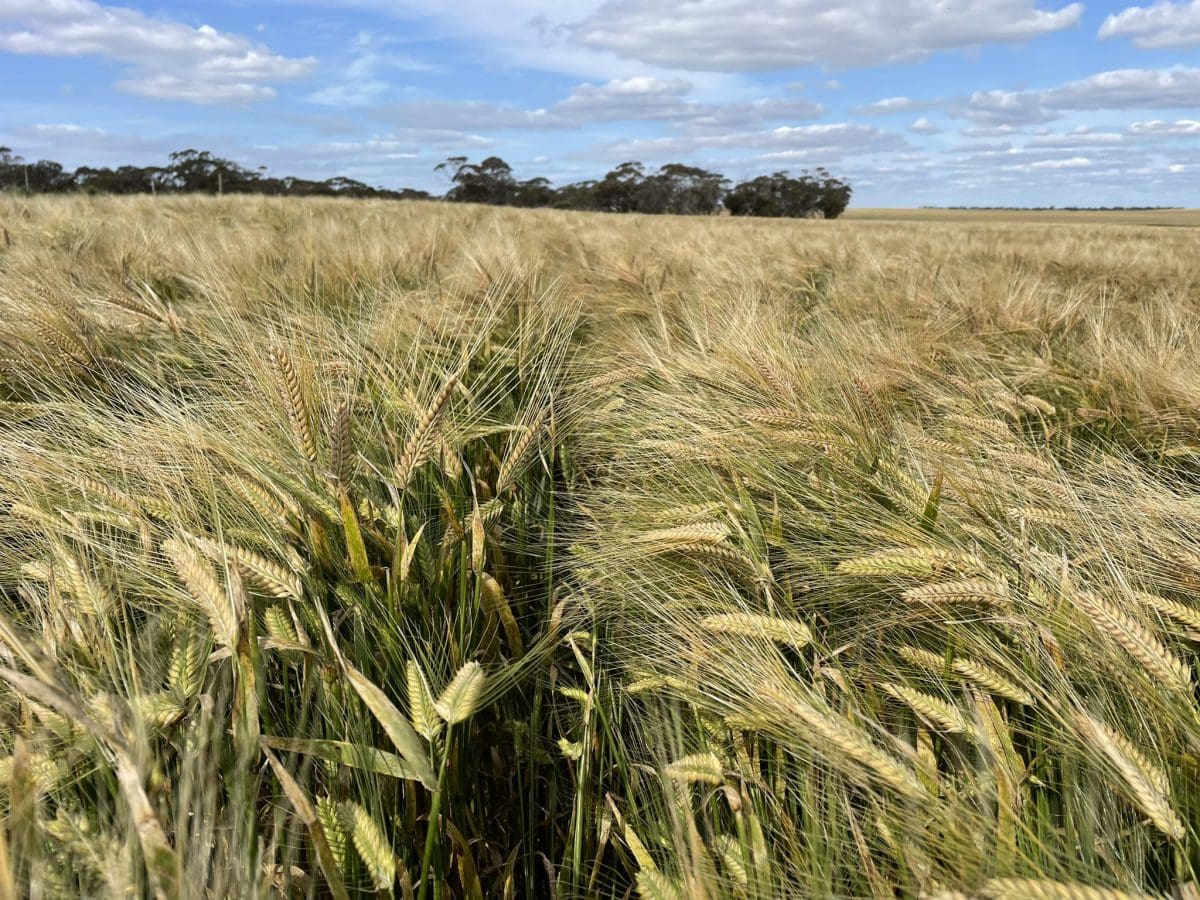
South Australian crops are performing well, including this barley crop in Loxton. Photo: Sean Matthewson
FEEDGRAINS have traded steady to higher in the past week as the impact of rain and cool weather further delays the impending start of harvest and makes accessing grain difficult at many sites.
Overhanging the market is the widening spread for protein wheat over lower grades.
These are expected to proliferate this year as successive rains lower prospects of anything above APW in most districts unless the weather turns hot and dry, and quickly.
With Australia now in its new marketing year, trade sources report export sales are slow, as volume of APW and above is uncertain, and SFW and ASW grades are expected to come under pressure from sheer volume.
| Prompt | Sep 30 | Jan-Feb | Sep 30 | |
| Barley Downs | $378 | $370 | $375 | $370 |
| SFW wheat Downs | $400 | $375 | $395 | $392 |
| Sorghum Downs | $370 | $365 | $345 | $345 |
| Barley Melbourne | $368 | $368 | $368 | $368 |
| ASW Melbourne | $420 | $420 | $440 | $440 |
| SFW Melbourne | $400 | $400 | $400 | $400 |
Table 1: Indicative prices in Australian dollars per tonne.
Access impacts north
Some short-lived rallies have been seen in the northern market this week, fuelled by consumers anxious to extend coverage to get them through to new-crop deliveries.
Most growers in Queensland were grateful to have a dry week, which has allowed the Central Queensland harvest to gather pace, and crops in the state’s south to start to turn, albeit amid mild daytime temperatures.
The mostly fine week is allowing growers to prepare for or plant sorghum and corn going into a full soil-moisture profile.
Downpours centred over central New South Wales ended a mostly dry week for the state, and with more rain forecast, some consumers are shoring up their prompt supplies by booking extra loads.
Robinson Grain Toowoomba-based trader Anthony Furse said the market was juggling a number of factors, including big stocks, rain-related access difficulties and offshore moves.
“The markets are more defined by nearby demand than anything; it’s consumers wanting security,” Mr Robinson said.
“Harvest is going to be potentially later than we’d thought, and the market’s up there for filling gaps.
“Otherwise, the market is very wide and quiet.”
Sorghum in the prompt market has rallied on the back of the weaker Australian dollar, and continuing demand from China, as the delayed wheat harvest gives sorghum exporters the chance to put together some late-season trades.
“That’s a nice little pop for growers with anything left over, but not many have any left over.”
Trade sources have reported significant premiums for on-farm or bulk-handling sites with all-weather access.
Stocks mixed in south
Crops in Victoria and South Australia are looking at bumper yields, and have mostly grown in ideal conditions as rain continues into grain-fill.
“The crops look amazing but everyone’s getting concerned about quality,” Riordan Grain Services general manager Mark Lewis said.
“There’s still a long way to go in Victoria, but lower protein is looking more likely.”
Mr Lewis said growers were forward selling conservative amounts of wheat on multigrade contract based on solid yield prospects.
Big carry-out stocks are sitting in NSW and in pockets of Victoria, and Mr Lewis said these were the buffer for the southern consumer, who continues to buy hand to mouth.
“They’ve just got to see what happens with quality but there’s so much stock around, they know if they need it, they can put their price up a bit and get it.”
In Victoria’s stockfeed sector, abundant pastures are lessening demand as expensive energy costs limit the operators’ incentive to run at maximum production.
Along with the rain, the scenario is likely to continue over the summer months.
In South Australia, a huge export program has run carry-out down to negligible levels.
“Last year we cleared out in SA, and we’re down to the last bits in the bunkers,” Australian Grain Export cereal trader Tyson Hewett said.
SA is also having its share of late-season rain and, like Victoria, many of its growing areas had 10-25 millimetres of rain in the week to 9am yesterday.
Mr Hewett said an abnormally wide spread between ASW and APW already on new-crop multigrade contracts indicated that protein could be scarce in SA as well as eastern states this year.
Nonetheless, some growers are booking modest tonnages of multigrade.
“APW is $440 and ASW is $405; that’s a big spread.
“SA is usually a big producer of APW and AH wheat; this year it might ASW and APW instead.”
Lentils usually kick off the SA harvest in late October, but Mr Hewett said an early November start was expected this year with the late planting and mild finish.
On barley, some growers are considering spray-topping their crops to tackle the weed burden, which would see deliveries automatically dropping into feed rather than malting segregations.

HAVE YOUR SAY